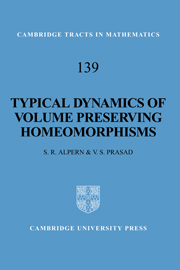Book contents
- Frontmatter
- Contents
- Historical Preface
- General Outline
- Part I Volume Preserving Homeomorphisms of the Cube
- Part II Measure Preserving Homeomorphisms of a Compact Manifold
- Part III Measure Preserving Homeomorphisms of a Noncompact Manifold
- Appendix 1 Multiple Rokhlin Towers and Conjugacy Approximation
- Appendix 2 Homeomorphic Measures
- Bibliography
- Index
Appendix 1 - Multiple Rokhlin Towers and Conjugacy Approximation
Published online by Cambridge University Press: 24 August 2009
- Frontmatter
- Contents
- Historical Preface
- General Outline
- Part I Volume Preserving Homeomorphisms of the Cube
- Part II Measure Preserving Homeomorphisms of a Compact Manifold
- Part III Measure Preserving Homeomorphisms of a Noncompact Manifold
- Appendix 1 Multiple Rokhlin Towers and Conjugacy Approximation
- Appendix 2 Homeomorphic Measures
- Bibliography
- Index
Summary
Introduction
The results presented in this chapter are purely measure theoretic and do not rely on any manifold structure on the underlying space. This is the reason we have grouped this material separately as an appendix. Most of this chapter is devoted to presenting the background, proof, and consequences of a result of the first author [13] that we call the Multiple Tower Rokhlin Theorem. The classical work of Rokhlin, Kakutani and Halmos showed that an antiperiodic automorphism of a finite Lebesgue space could be nearly represented as a single stack, or ‘tower’, consisting of disjoint iterates of a ‘base’ set. The modification presented here as Theorem A1.4 shows that it can be exactly represented as a collection of disjoint towers of prescribed heights and measures, as long as the set of heights is relatively prime. This result was in fact motivated by questions related to manifold homeomorphisms, and indeed corollaries of this tower theorem are applied several times in the main text. An infinite measure analog of our tower theorem established by the authors and Jal Choksi, our Theorem A1.15 and Corollary A1.16, also has important implications for manifold homeomorphisms preserving an infinite measure. That application forms the basis of Chapter 17.
This chapter is organized as follows. Section A1.2 reviews the basic ‘skyscraper’ construction developed by Kakutani [75] and others.
- Type
- Chapter
- Information
- Typical Dynamics of Volume Preserving Homeomorphisms , pp. 160 - 187Publisher: Cambridge University PressPrint publication year: 2001



